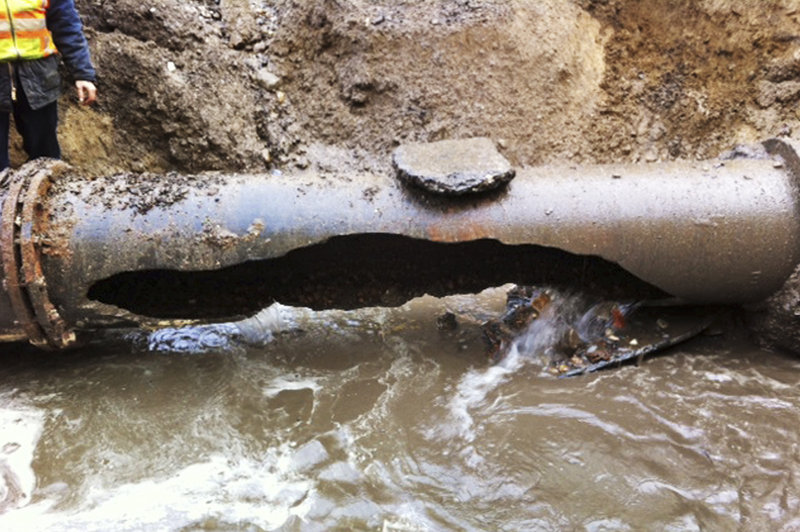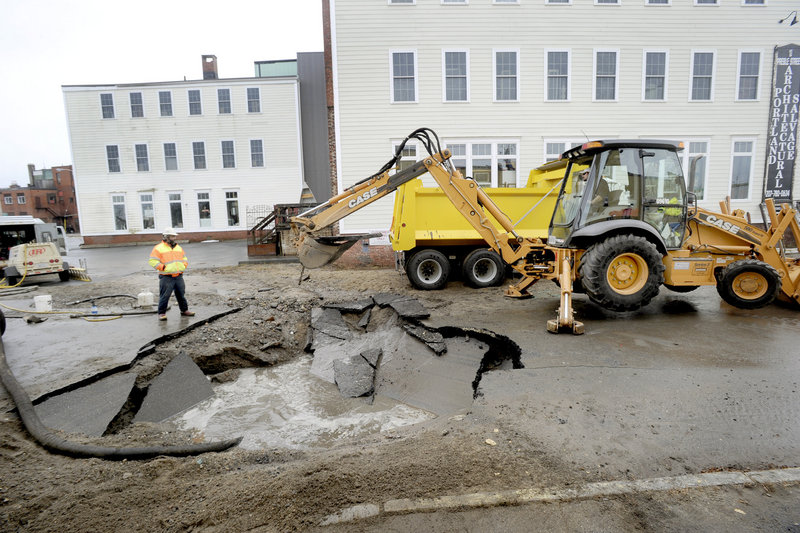PORTLAND – Wednesday’s rupture of a century-old water main that flooded Somerset Street, disrupted 4,000 homes and businesses and prompted a 24-hour boil-water notice exposed a stark reality: Most of Portland’s water pipes are old.
“Aging infrastructure is a significant issue for our industry, and that’s a nationwide concern,” said Michelle Clements, public relations manager for the Portland Water District, which serves Portland and 10 surrounding communities.
The cast-iron water main that broke Wednesday was not the city’s oldest. Some lines date to the late 1800s.
Within the water district, Portland and South Portland have the oldest water lines, and the most heavily used lines.
Water mains can break for various reasons, but the age of Portland’s pipes – and the fact that not nearly enough money is budgeted to replace old pipes suggest that breaks could become more common.
The Portland Water District, which has more than 1,000 miles of pipes, has had a water main improvement program since 1985. It budgets money each year to replace old pipes.
The district examines several factors before deciding which mains to replace, including age, whether there have been previous breaks and whether there have been complaints from customers, Clements said.
The program’s current budget is $3 million a year.
“To replace everything that needs to be replaced systemwide would cost $630 million,” Clements said.
The district could increase its budget, but any increase likely would be shouldered by ratepayers. The last rate increase came in 2011.
Norm Lamie, chief engineer for the Maine Drinking Water Program, said the life span of cast iron water mains is generally 75 to 125 years. Factors such as the type of soil around the pipes can affect how long they last.
Lamie said the standard in the industry is to replace 1 percent of pipes per year, but funding rarely goes that far.
The Maine Drinking Water Program provides money to water districts on an application basis and is expected to distribute $13 million for new infrastructure next year.
Clements said water main breaks are a reality for cities with old infrastructure, although the Portland Water District has actually had a 30 percent decline in the past decade.
A water main break in September flooded businesses along Broadway in South Portland. Clements said at the time that the water district typically has about 100 breaks a year.
None of the breaks in recent years was as big as Wednesday’s rupture. The last break of such magnitude occurred in 1996, Clements said, when a handful of breaks occurred at the same time.
Wednesday’s break was reported at 7:44 a.m. Because of the possibility of contamination, a boil-water notice was issued an hour and a half later.
When a water main breaks, the pressure in pipes decreases significantly. That can allow sediment and bacteria to get into the water supply.
“Any time we have a break, there is potential for contamination, so this was a precaution,” Clements said.
The district collected a dozen water samples after the break. Each was tested for contamination and each came back clean.
The boil-water notice wasn’t lifted until Thursday morning because the testing took a minimum of 18 hours.
Businesses scrambled Wednesday to stay open, but some had to close.
Cozy Harbor Seafood, a seafood processing plant on Commercial Street, closed because of the possibility that its water supply was unsafe. John Norton, the company’s president, said the first concern was food safety.
Still, the plant took a financial hit. Norton said the break forced a two-day shutdown of his plant, putting 130 employees out of work for two days.
Restaurants on Portland’s peninsula were most affected. City officials alerted establishments about the boil-water notice, and health inspectors, police officers and code inspectors visited restaurants.
Jaci Rubchinuk, general manager of the Five Guys restaurant on Fore Street, said she was able to serve the lunch crowd Wednesday by using bottled water but the restaurant closed after that, losing the day’s dinner business.
“We had to hustle to get ready Thursday morning,” she said. “But we don’t want to be the business that takes a chance. We’ll have to make up the loss somewhere else.”
Some businesses didn’t miss a beat.
Darcy Hanson, a manager at the Ri Ra Irish Pub on Commercial Street, said the staff worked hard Wednesday morning to get ready for the lunch crowd.
“We started boiling water right away. We worked diligently with our vendors. We got I don’t know how many pounds of ice” because the pub couldn’t use its own, she said. “Our staff handled it great.”
The broken pipe was repaired by 10:30 p.m. Wednesday, but other damage on Somerset Street is still being assessed, Clements said. She could not say how much repairs will cost or exactly what caused the line to rupture.
The biggest cost to the district, she said, will be to repave Somerset Street, which suffered significant damage from flooding. That work was just getting under way Thursday.
Many cars that were parked in Bayside when the main broke sustained water damage.
The water district recommends that anyone who suffered damage file a claim with their insurance company. Claims also can be filed with the water district, but the utility is generally exempt from liability unless negligence is proven.
Norton said Cozy Harbor likely will file an insurance claim, but he’s not convinced it will do any good.
“The last time this happened (in 1996), it wasn’t covered,” he said.
Staff Writer Eric Russell can be contacted at 791-6344 or at:
erussell@pressherald.com
Twitter: @PPHEricRussell
Send questions/comments to the editors.





Success. Please wait for the page to reload. If the page does not reload within 5 seconds, please refresh the page.
Enter your email and password to access comments.
Hi, to comment on stories you must . This profile is in addition to your subscription and website login.
Already have a commenting profile? .
Invalid username/password.
Please check your email to confirm and complete your registration.
Only subscribers are eligible to post comments. Please subscribe or login first for digital access. Here’s why.
Use the form below to reset your password. When you've submitted your account email, we will send an email with a reset code.